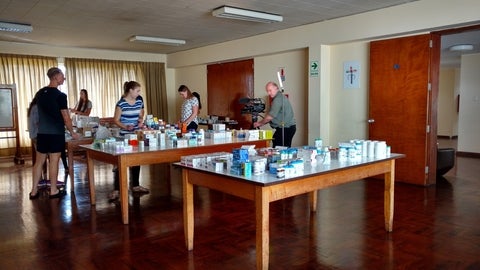
For the third year in a row, Waterloo Pharmacy joined a Solidarity Experiences Abroad (SEA) excursion and sent pharmacy students on a healthcare mission in Peru. Sonya Dhanjal, Loran Ellero-Dionne, and Saptha Navaratnam travelled to South America this summer to support four healthcare clinics in different parts of Lima. Peru has a population of about 31 million, and nearly 10 million of these people live in Lima. Lima is Peru’s capital and the third-largest city in South and Central America.
“I wanted to understand how healthcare works in another country,” says Dhanjal, thinking back to when she applied for the trip. “I was excited by the challenge of running a pharmacy with limited resources and the prospect of getting to use my pharmacy skills in a new way.”
The students travelled to Peru with a team of seven physicians, one pharmacist, twenty first year medical students, six undergrads, and a videographer. Their suitcases contained more medications than personal belongings: bringing donations and supplies is common practice for this type of direct aid work.

The SEA volunteers ran four clinics in total. Ellero-Dionne worked at two in Lima’s more rural and shantytown areas. These clinics were run in partnership with a local organization and the majority of care was provided by Peruvian doctors and medical students, with assistance from a few of the volunteers.
Dhanjal and Navaratnam were at the clinics in Santa Maria and Policlinico with the rest of the team.

“Because we had several clinics, inventory management was a big concern,” explains Dhanjal. “We had limited resources and medications that were close to expiring. During our morning briefings we’d identify which medications expired when. Even if it wasn’t typically used to treat a condition, if a medication was close to expiring and would be safe and effective, we’d prioritize using it so that we could best utilize our stock and serve as many people as possible."

A typical day involved patients being triaged, receiving a physician consult, and then visiting the pharmacy. The pharmacy students ran the pharmacies at both clinics. They received prescriptions and dispensed medications, working with a translator to counsel patients. For many Peruvians, the SEA clinics are the only opportunity for them to access healthcare all year.
“The clinics made healthcare accessible to people who couldn’t otherwise access it,” says Dhanjal. “It felt good to make a difference at an individual level, but at the same time I was a little conflicted since we couldn’t always address the underlying reasons that prevent access to care. We want to help but we don’t want to make the country rely on non-government organizations for healthcare.”
Blood glucose testing, adapting prescriptions, and managing inventory were essential parts of each day at the clinic. For many patients, poor nutrition or unmanaged chronic conditions were concerns. Antibiotics, multivitamins, and inhalers were some of the most commonly prescribed items, and patients were always grateful to receive medications.

“Exploring Peruvian culture and history was one of my goals in going on the trip,” Dhanjal reflects. “I was surprised at how familiar it felt to serve this community. Even with the language barrier, our patients wanted to feel a connection with those taking care of them, no different from North American patients.”
